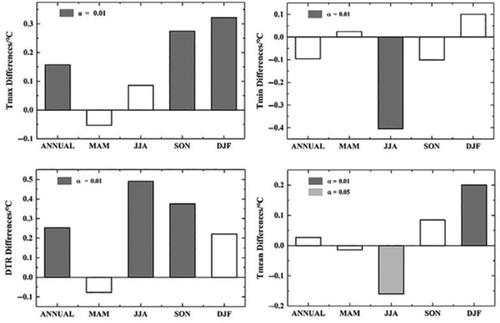当前位置:
X-MOL 学术
›
Meteorol. Appl.
›
论文详情
Our official English website, www.x-mol.net, welcomes your
feedback! (Note: you will need to create a separate account there.)
Reducing air pollution increases the local diurnal temperature range: A case study of Lanzhou, China
Meteorological Applications ( IF 2.3 ) Pub Date : 2020-07-24 , DOI: 10.1002/met.1939 Xueyan Cheng 1 , Tianhan Lan 1 , Rui Mao 1, 2 , Dao‐Yi Gong 1, 2 , Hui Han 3 , Xiaohong Liu 4
Meteorological Applications ( IF 2.3 ) Pub Date : 2020-07-24 , DOI: 10.1002/met.1939 Xueyan Cheng 1 , Tianhan Lan 1 , Rui Mao 1, 2 , Dao‐Yi Gong 1, 2 , Hui Han 3 , Xiaohong Liu 4
Affiliation

|
Lanzhou is one of the largest heavy industry cities in northwestern China. The city has carried out massive air pollution‐control programmes since 2012. As a result, the concentrations of air pollutants in Lanzhou have decreased. In order to examine the effects of air pollution‐control programmes on air temperature, the differences in air temperatures between Lanzhou and Yuzhong (a small county adjacent to Lanzhou) and their change between 2009–2011 (P1) and 2013–2015 (P2) were calculated. The results showed that the maximum (minimum) temperature difference significantly increased (decreased) by 0.32°C (0.40°C) in winter (summer) between P1 and P2, indicating an increase (decrease) of the maximum (minimum) temperature in winter (summer) in Lanzhou caused by the reduction in air pollution. Therefore, the diurnal temperature range in Lanzhou increased by 0.50°C in summer and 0.22°C in winter during P2 compared with P1. The increase in the maximum temperature in winter and the decrease in the minimum temperature in summer are supported by a decrease in mean air temperature at night and by an increase of mean air temperature in daytime in winter and summer during P2 compared with P1. The increase in temperature in daytime may be ascribed to more absorption of solar radiation at the surface. The decrease in temperature at night in summer is caused by increasing light rainfall. The decrease in temperature at night during winter may be related to more loss of surface heat through long wave radiation.
更新日期:2020-07-24











































 京公网安备 11010802027423号
京公网安备 11010802027423号